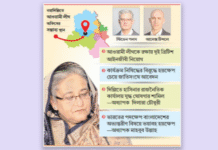
The number of patients was only 184 in May but rose to 1,796 in June
Four and a half year old Tahmeed Mehbub, admitted to a private hospital in Dhaka on July 14 with heavy fever and body pain, was diagnosed with dengue.
Within a day of his admission, his condition deteriorated rapidly and he developed difficulty in breathing. Doctors said it was pulmonary edema, a condition caused by excess fluid in the lungs.
He was sent to the Pediatric Intensive Care Unit (PICU) where he was undergoing treatment up until Sunday, before he was shifted to a cabin.
“It was terrible. Our son is still in critical condition. We took prompt and timely measures and could save him, and we were lucky we had the ability to manage the situation, but there are many who are less fortunate. The government should announce the outbreak as an epidemic right now, with more awareness campaigns,” said Shahed Mehbub, father of Tahmeed.
He said all six beds at the PICU are now occupied by dengue patients and the blood bank of the hospital is always crammed with patient attendants looking for blood and donors to save victims.
Tahmeed is one of the patients whom doctors managed to save with difficulty.
Dhaka hospitals are struggling to cope with the increasing flow of dengue patients. The number of admitted patients in various hospitals across the country has reached over 6,500 in the last seven months.
According to Directorate General of Health Services (DGHS) data, from January 1 to July 21, 6,544 people were admitted to different public and private hospitals infected by the dengue virus.
Currently, 1,558 patients are undergoing treatment, said Health Emergency Operation Centre sources and the Control Room of DGHS.
The number of patients was only 184 in May but rose to 1,796 in June.
|
– Dhaka hospitals crammed with dengue patients. 4,500 affected this month alone
– Over 6,500 infected, five die. Unofficial death figures are more than 20 dead in 7 months – HC says it is nothing less than an epidemic – Mosquito killing insecticides less effective – WHO terms the situation alarming |
In the first 21 days of July, the number of patients was 4433, almost 2.5 times higher than last month.
Unofficial records say the number of infected people is much higher with the death toll reaching over 20 spread across various hospitals.
Dengue, a mosquito-borne virus, spreads among humans when an infected Aedes mosquito bites them. The disease has no known cure or vaccine yet.
The High Court on July 17 said the dengue situation in the capital is nothing short of an epidemic.
Saying that 21 to 22 people, including children, have reportedly died and hundreds fallen victim to dengue fever, a High Court bench of Justice FRM Nazmul Ahasan and Justice KM Kamrul Kader, slammed both city corporations for not taking appropriate action, even after an order was issued by the court in this regard.
Crammed hospitals
Most Dhaka hospitals are now crammed with dengue patients while doctors at many hospitals are struggling to manage the flow of more incoming patients.
If this keeps up, the numbers may cross last year’s record, they feared.
Doctors said the government should announce it as an epidemic right now to let people know about the actual severity of this public health crisis.
Liza Akhter, mother of a patient at Holy Family Hospital was worried. They spent Tk50,000 last month for the treatment of their daughter, which crossed Tk80,000 this month.
“I have other children who might get infected too. How can one person provide for the treatment of a family of four?” she questioned, requesting the government make the treatment of dengue free for all.
Dr Edwin Salvador, acting representative of World Health Organization (WHO) in Dhaka, reckons the dengue situation in Bangladesh is indeed alarming.
Salvador said the number of dengue patients is rising as are the numbers of tiny suspects: mosquitos.
The situation is deteriorating and it will turn into an epidemic if the trend continues, he added.
Doctors say the country is experiencing a worse-than-usual attack of the potentially deadly dengue fever this year, as the pattern of the symptoms is changing.
Previously, high fever, rashes, and vomiting, were considered to be the symptoms. Now, new symptoms like loose motion, pneumonia, and renal failure have surfaced.

Mahmudur Rahman, former director of the Institute of Epidemiology Disease Control and Research (IEDCR) said the dengue virus is changing its pattern and that is one reason why the dengue outbreak is serious this year.
Earlier, there were two types of dengue viruses in Bangladesh and other countries in this region, but in the last two years, people are being affected by a third type of virus, he said.
He recommended patients should see a doctor immediately if they experience any symptoms of dengue.
The virus is affecting vital organs such as the liver, kidneys, and the heart, making patients more vulnerable, he added.
Lutful Ehsan Fatmi, head of the Department of Child Health at Holy Family Hospital, said the number of dengue patients was increasing every day and it has turned so alarming that the hospital had to open a new section to deal with dengue.
“Certainly, it’s an epidemic,” he said, adding that numerous people becoming infected at the same time fits the definition of an epidemic.
Ineffective insecticides
The majority of insecticides used by the two city corporations in the capital have proved ineffective against Aedes Aegypti, according to a recent study.
Mohammad Shafiul Alam, a researcher at the International Center for Diarrhoeal Disease Research, Bangladesh (icddr,b) that conducted the survey, said they found mosquitoes in Dhaka fully resistant to Permethrin, the main insecticide used by Dhaka city corporations.
Sources at the two city corporations said they are aware of the study and are trying to switch insecticides, but bureaucratic procedures mean the switch cannot be made immediately.
Cases likely to increase
Dr Ayesha Akther, assistant director at the DGHS control room said dengue cases are likely to increase during the rainy season from July to August.
She said to look out for symptoms such as high temperature (rising to more than a 104 degrees Fahrenheit), severe headache, pain behind the eyes, nausea, vomiting, swollen glands, muscle and joint pains, and rashes.
Dr Azharul Islam Khan, Head of Hospitals at icddr,b, told Dhaka Tribune that CBC (complete blood count) tests should be run on dengue patients twice a day because platelet counts can fall drastically.
“A patient’s platelet count may not be life threatening in the morning but it might be so by evening. This is why CBC tests should be done twice daily,” he said. He also said patients should not take pain killers without consulting a doctor and should wait at least six hours between doses of paracetamol, he said.
Dhaka a perfect breeding ground
Areas with stagnant water, plastic and metal buckets, discarded tyres, plastic mugs and drums, flower tubs, clay and paint pots, and water tanks left open and uncovered are potential breeding grounds for mosquitoes in Dhaka.
A survey conducted by the Disease Control Division of DGHS, revealed between March 3 and 12, that some areas under Dhaka North City Corporation (DNCC) and Dhaka South City Corporation (DSCC) are perfect breeding grounds for the Aedes mosquito.
Tejgaon, Turag, Pallabi, Magbazar, Uttara, Gulshan, Banani, Kafrul, Khilgaon, Rampura, Mirpur, Pirerbagh, Mohammadpur, Shewrapara, Kazipara, Banani, Kazipara, Banani and Baridhara under the DNCC, have been identified as vulnerable.
Under DSCC’s jurisdiction, Dayaganj, Narinda, Swamibag, Gendaria, Dhakkin Mugdapara, Basabo, Maniknagar Biswa Road, She-e-Bangla Nagar, Hazaribag, Moghbazar, Ramna, Segunbagicha, Shahbag, Farashganj, Syampur, and Uttar Jatrabari, are dengue prone.
Source: Dhaka Tribune.









